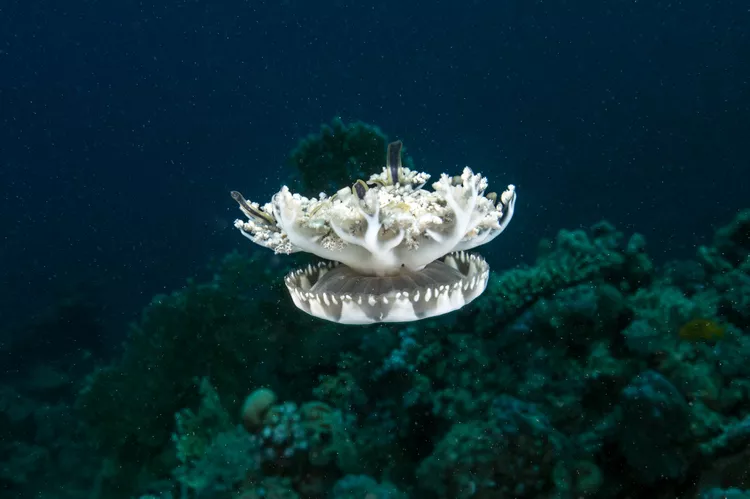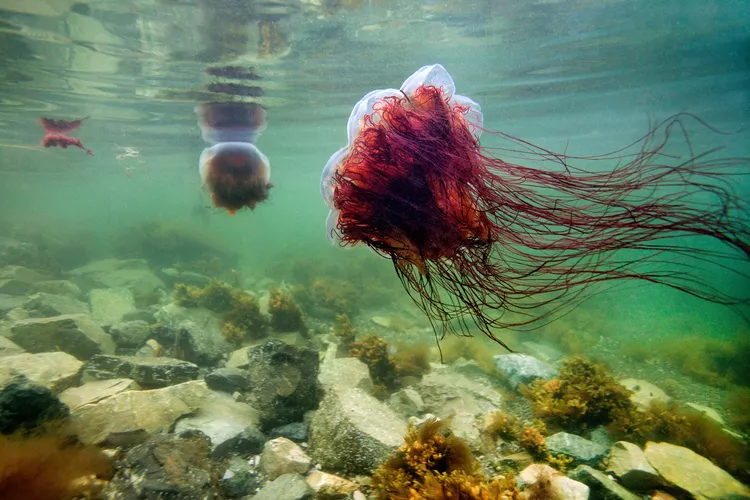Jellyfish are one of the ocean’s most unique and mysterious creatures. With their translucent bodies, long flowing tentacles, and otherworldly appearance, they have fascinated humans for centuries. But did you know that some jellyfish can be dangerous? In fact, many species pack a punch with venom that can cause everything from mild irritation to severe pain—or even death. In this article, we’ll dive deep into the world of jellyfish and explore 10 of the coolest and most fascinating species you should know about. We’ll also cover the level of toxicity each one brings to the table.
The Cauliflower Jellyfish (Cephea cephea) is one of the most bizarre-looking jellyfish, with its large, flower-like bell covered in tubercles. Found in the Indo-Pacific and West African coasts, these jellyfish have a bell diameter of up to 60 cm (about 2 feet). Though they look graceful, they are actually pretty good at trapping plankton with their long, stinging tentacles.

Toxicity: Cauliflower jellyfish aren’t highly toxic to humans. Their sting may cause mild irritation, but it’s unlikely to be dangerous. However, sensitive individuals might experience some skin rashes or swelling.
Known for its square, box-like bell, the Box Jellyfish (Chironex fleckeri) is considered one of the deadliest creatures in the ocean. Found in the warm coastal waters of the Indo-Pacific, including Australia, this jellyfish is feared for its venom, which can be fatal to humans in just a few minutes.

Toxicity: Extremely high. Box jellyfish venom contains toxins that attack the heart and nervous system, often leading to cardiac arrest. A sting from a box jellyfish requires immediate medical attention, as it can cause intense pain, paralysis, and death if not treated.
The Crystal Jellyfish (Aequorea victoria) is famous for its clear, glass-like body and its ability to emit a bioluminescent glow in the dark. Found along the Pacific coasts of North America, these jellyfish are often studied by scientists for their unique bioluminescence.

Toxicity: Low. While they do have venom in their tentacles, Crystal Jellyfish are not dangerous to humans. The sting is mild and may cause minor irritation or itching. They’re more famous for their glowing beauty than their toxicity.
The Lion’s Mane Jellyfish (Cyanea capillata) is the largest known species of jellyfish, with tentacles that can stretch over 120 feet (36 meters). Found in cold waters like the North Atlantic and the North Pacific, its mane-like tentacles give it a unique and terrifying look.

Toxicity: Moderate to high. The venom of the Lion’s Mane Jellyfish can cause severe pain and skin irritation, sometimes leading to more serious reactions like difficulty breathing. While fatalities are rare, their sting is no joke, and medical attention is recommended if stung.
As the name suggests, the Upside-Down Jellyfish (Cassiopea spp.) spends most of its life with its bell facing down and its tentacles reaching up. This jellyfish is usually found in shallow, warm waters, like the Caribbean and Florida. The unique position allows it to catch sunlight and use photosynthesis thanks to the symbiotic algae living in its tissues.

Toxicity: Low. While Upside-Down Jellyfish have venomous tentacles, their sting is typically not dangerous to humans. However, it can cause mild irritation or a rash in some people.
The Black Sea Nettle (Chrysaora achlyos) is a massive jellyfish with dark, almost black tentacles that can grow up to 25 feet (7.6 meters) in length. It’s found in the deep waters off the coast of Southern California and can sometimes appear near the surface in large swarms.

Toxicity: Moderate. Black Sea Nettles’ stings are painful and can cause intense burning sensations. While they are not as dangerous as Box Jellyfish, their sting can still be uncomfortable and cause nausea, dizziness, and pain. Immediate care is recommended if stung.
The Egg Yolk Jellyfish (Cotylorhiza tuberculata) gets its name from its bright yellow bell that resembles a fried egg. These jellyfish are found in the Mediterranean Sea and are known for their stunning, vibrant appearance.

Toxicity: Low. Egg Yolk Jellyfish are relatively harmless to humans. Their sting is mild, causing only minor irritation. They are more of a visual spectacle than a dangerous species to watch out for.
The Moon Jellyfish (Aurelia aurita) is perhaps the most recognizable jellyfish, with its translucent, moon-shaped bell and a distinctive four-leaf clover pattern visible in the center. Found in oceans around the world, from the North Atlantic to the South Pacific, these jellyfish are commonly seen in aquariums.

Toxicity: Low. Moon Jellyfish have a mild sting that is usually harmless to humans, although some people may experience a slight rash or itching. They are not considered dangerous, but their sting can cause minor discomfort.
The Atolla Jellyfish (Atolla wyvillei) is known for its ability to emit flashes of light when threatened. This glowing display serves as an “alarm,” alerting predators to the jellyfish’s location. Found in the deep sea, this jellyfish is rarely encountered by humans.

Toxicity: Low. The Atolla Jellyfish’s sting is not harmful to humans, though it can cause some mild irritation. Its bioluminescent display is much more fascinating than its venomous capabilities.
The Night Jellyfish (Stygobromus hayi) lives in the deep waters, often at depths where light barely reaches. They use their bioluminescence to hunt prey and communicate with other jellyfish.

Toxicity: Low to moderate. The Night Jellyfish has venomous tentacles, but they’re not particularly dangerous to humans. Still, their sting can cause mild irritation or discomfort if touched.
Jellyfish are truly amazing creatures, from their glowing bodies to their diverse shapes and behaviors. Whether you’re fascinated by their bioluminescence or their extreme toxicity, they are definitely worth learning more about. If you’re heading to the beach or the ocean, remember to be aware of the jellyfish species in the area and always exercise caution. Some jellyfish stings can be dangerous, but with the right knowledge, you can safely enjoy these incredible creatures from a distance. Stay safe and be jellyfish-smart!
animal tags: Jellyfish
We created this article in conjunction with AI technology, then made sure it was fact-checked and edited by a Animals Top editor.